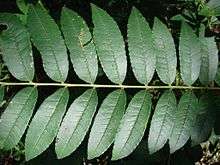Zanthoxylum rhoifolium
| Zanthoxylum rhoifolium | |
|---|---|
 | |
| A leaf of Zanthoxylum rhoifolium with many pairs of leaflets. | |
| Scientific classification | |
| Kingdom: | Plantae |
| (unranked): | Angiosperms |
| (unranked): | Eudicots |
| (unranked): | Rosids |
| Order: | Sapindales |
| Family: | Rutaceae |
| Genus: | Zanthoxylum |
| Species: | Z. rhoifolium |
| Binomial name | |
| Zanthoxylum rhoifolium | |
Zanthoxylum rhoifolium is a species of tree in the citrus family known by the common names mamica de cadela,[1] tambataru,[2] and prickly ash.[2][3] It is native to South America.[4][5] It is a common tree on the Cerrado.[6]
Description
This species is a deciduous tree reaching up to 12 meters in height.[6] It produces a spherical black capsule about half a centimeter in length and width containing small, hard-coated seeds.[6]
Ecology
The tree is not shade tolerant, so it can be found in open areas in and around forests.[6]
Uses
This is a medicinal plant. The bark is used to treat toothache and earache.[1] It is used as an anti-inflammatory.[4] It is used to treat malaria.[4][7][8] Parts of the plant also have antibacterial[3] and fungicidal[9] action.
Chemical compounds
It contains nitidine, an alkaloid with anti-malarial action.[8] It is of commercial value as a component of herbal remedies for malaria.[4]
References
- 1 2 Pereira, S. S., et al. (2010). Antinociceptive effect of Zanthoxylum rhoifolium Lam. (Rutaceae) in models of acute pain in rodents. J Ethnopharmacol 129(2):227-31
- 1 2 Begossi, A., et al. (1993). Plant uses in a Brazilian coastal fishing community (Buzios Island). J Ethnopharmacol 13(2) 233-56.
- 1 2 Duke, J. A. Duke's Handbook of Medicinal Plants of Latin America. CRC Press 2008.
- 1 2 3 4 da Silva, S. L., et al. (2007). Cytotoxic evaluation of essential oil from Zanthoxylum rhoifolium Lam. leaves. Acta Amaz 37(2)
- ↑ Grandtner, M. M.; Chevrette, Julien (2013). Dictionary of Trees, Volume 2: South America: Nomenclature, Taxonomy and Ecology. Academic Press. p. 712. ISBN 9780123969545.
- 1 2 3 4 Silva, I. A., et al. (2009). Fire effects on the population structure of Zanthoxylum rhoifolium Lam (Rutaceae) in a Brazilian savanna. Braz J Biol 69(3) 813-18.
- ↑ Jullian, V., et al. (2006). Validation of use of a traditional antimalarial remedy from French Guiana, Zanthoxylum rhoifolium Lam. J Ethnopharmacol 106 348-52.
- 1 2 Bouquet, J., et al. (2012). Biological activities of nitidine, a potential anti-malarial lead compound. Malaria Journal 11:67
- ↑ Prieto, J., et al. (2011). Chemical composition, insecticidal, and antifungal activities of fruit essential oils of three Colombian Zanthoxylum species. Chilean Journal of Agricultural Research 71(1) 73-82.